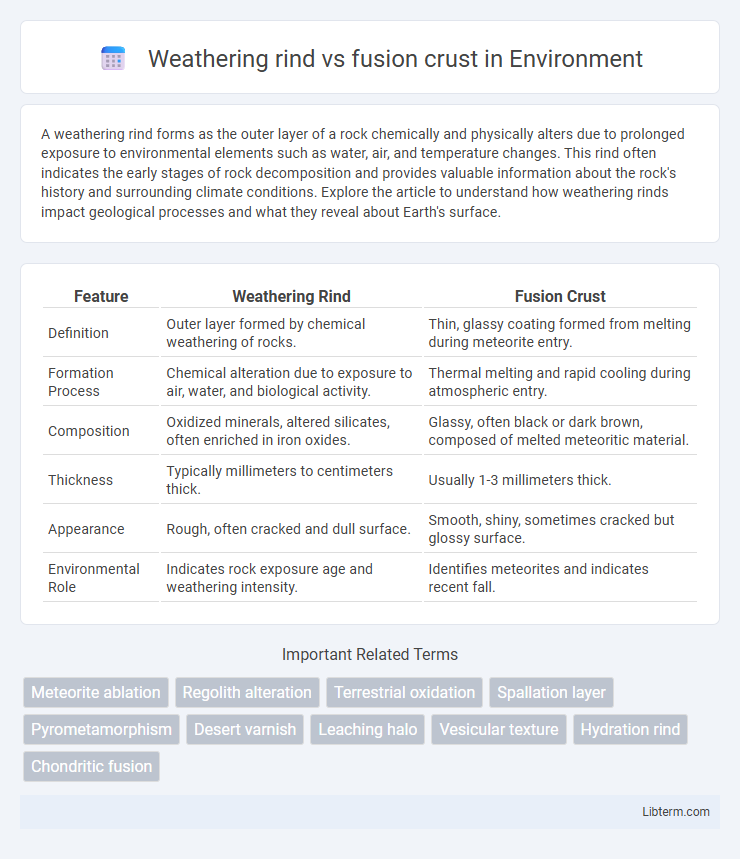A weathering rind forms as the outer layer of a rock chemically and physically alters due to prolonged exposure to environmental elements such as water, air, and temperature changes. This rind often indicates the early stages of rock decomposition and provides valuable information about the rock's history and surrounding climate conditions. Explore the article to understand how weathering rinds impact geological processes and what they reveal about Earth's surface.
Table of Comparison
| Feature | Weathering Rind | Fusion Crust |
|---|---|---|
| Definition | Outer layer formed by chemical weathering of rocks. | Thin, glassy coating formed from melting during meteorite entry. |
| Formation Process | Chemical alteration due to exposure to air, water, and biological activity. | Thermal melting and rapid cooling during atmospheric entry. |
| Composition | Oxidized minerals, altered silicates, often enriched in iron oxides. | Glassy, often black or dark brown, composed of melted meteoritic material. |
| Thickness | Typically millimeters to centimeters thick. | Usually 1-3 millimeters thick. |
| Appearance | Rough, often cracked and dull surface. | Smooth, shiny, sometimes cracked but glossy surface. |
| Environmental Role | Indicates rock exposure age and weathering intensity. | Identifies meteorites and indicates recent fall. |
Introduction to Weathering Rind and Fusion Crust
Weathering rind forms as a result of prolonged chemical and physical alteration of rock surfaces exposed to atmospheric conditions, typically developing over thousands of years. Fusion crust appears as a thin, glassy coating created by the intense heat generated when meteorites pass through the Earth's atmosphere during entry. Understanding the distinct formation processes and characteristics of weathering rind and fusion crust is essential for identifying terrestrial versus extraterrestrial rock samples.
Definition: What is a Weathering Rind?
A weathering rind is the outermost layer of rock that forms through chemical and physical weathering processes, resulting in a distinct, often discolored or altered surface compared to the unaltered interior. This rind typically develops over long periods due to exposure to environmental factors such as moisture, temperature fluctuations, and atmospheric gases. Unlike a fusion crust, which forms rapidly during meteorite entry by melting the rock's surface, a weathering rind reflects gradual, terrestrial alteration.
Definition: What is a Fusion Crust?
A fusion crust is a thin, glassy outer layer formed on a meteorite's surface when it rapidly melts and cools during its fiery passage through Earth's atmosphere. This crust typically appears black or dark brown due to the intense heat that causes the outer minerals to melt and solidify quickly. Unlike a weathering rind, which develops through terrestrial chemical weathering over time, a fusion crust is created instantaneously during atmospheric entry.
Formation Process of Weathering Rind
The formation process of a weathering rind involves the chemical alteration of exposed rock surfaces through prolonged interaction with atmospheric moisture, oxygen, and other environmental agents, leading to mineral decomposition and the development of a distinct outer layer. This rind gradually thickens over time as weathering progresses, often displaying altered colors and textures compared to the unweathered interior rock. Unlike a fusion crust, which forms instantly through the rapid melting of meteoritic material during atmospheric entry, a weathering rind develops slowly via surface chemical weathering.
Formation Process of Fusion Crust
Fusion crust forms during a meteorite's rapid passage through Earth's atmosphere, where intense heat melts the outer surface, creating a thin, glassy layer. This process involves ablation, where gases and molten material are stripped away, leaving a smooth, often blackened crust. Unlike weathering rind, which develops slowly through terrestrial chemical alteration, fusion crust results from instantaneous thermal transformation.
Visual and Physical Differences
Weathering rind appears as a rough, often dull outer layer on rocks, formed through prolonged chemical alteration and oxidation processes, resulting in a crumbly texture and earthy colors such as reddish-brown or yellowish hues. Fusion crust forms on meteorites during atmospheric entry, exhibiting a thin, glassy, smooth, and glossy surface with dark black or dark brown coloration due to rapid melting and cooling. Physically, weathering rind is thicker and porous, reflecting terrestrial exposure, while fusion crust is a thin, dense, and brittle coating indicative of extraterrestrial origin.
Geological Significance and Identification
Weathering rind forms through chemical alteration of rocks at Earth's surface, revealing important information about weathering processes and environmental conditions over time. Fusion crust develops rapidly during meteoroid atmospheric entry, characterized by a thin, dark, glassy layer, essential for identifying meteorites and understanding their thermal history. Differentiating between these features aids geologists in distinguishing terrestrial rock alteration from extraterrestrial materials.
Occurrence: Where Are They Found?
Weathering rinds are typically found on terrestrial rocks exposed to surface conditions over long periods, especially in soil profiles and desert environments where chemical and physical weathering processes dominate. Fusion crusts occur exclusively on meteorites, forming as a thin, glassy layer on the outer surface during atmospheric entry when intense heat melts the outermost layer. Both features provide critical clues about the environmental history and origin of the rock specimen.
Importance in Meteorite Studies
The weathering rind and fusion crust are critical for interpreting meteorite alteration histories and terrestrial exposure. The weathering rind, forming through chemical alteration after landing on Earth, indicates the duration and environmental conditions influencing the meteorite's surface. The fusion crust, created during atmospheric entry by rapid melting and quenching, provides insights into the meteorite's entry velocity, angle, and thermal history before impact.
Conclusion: Key Distinctions and Implications
Weathering rinds form through prolonged chemical alteration of rock surfaces in terrestrial environments, resulting in gradual mineralogical changes and distinctive coloration. Fusion crusts develop rapidly during meteoroid atmospheric entry, characterized by a thin, glassy layer formed by melting and quenching processes. Understanding these key distinctions aids in accurate identification of geological versus extraterrestrial specimens and informs studies in planetary geology and meteorite classification.
Weathering rind Infographic

 libterm.com
libterm.com